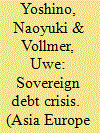|
|
|
Sort Order |
|
|
|
Items / Page
|
|
|
|
|
|
|
| Srl | Item |
| 1 |
ID:
144857


|
|
|
|
|
| Summary/Abstract |
Japan has suffered from sluggish economic growth and recession since the early 1990s. In this paper, we analyze the causes of the prolonged slowdown of the Japanese economy (the lost decade). Economics Nobel laureate Paul Krugman has argued that Japan's lost decade is an example of a liquidity trap. However, our empirical analysis shows that stagnation of the Japanese economy comes from its vertical IS curve rather than a horizontal LM curve, so the Japanese economy has been facing structural problems rather than a temporary downturn. The vertical IS curve is caused by an insensitivity of investment to a lower interest rate partly because of the decline of sales due to the aging population and firms not wanting to invest. The structural problems come from the aging demographic, which is often neglected by scholars and policy-makers, and also from the allocation of transfers from the central government to local governments, and the unwillingness of Japanese banks to lend money to startup businesses and small and medium enterprises (SMEs), mainly because of Basel capital requirements. Many countries, like China, are expected to face similar issues, particularly given the aging population. The present paper will address why the Japanese economy has been trapped in a prolonged slowdown and provide some remedies for revitalizing the economy.
|
|
|
|
|
|
|
|
|
|
|
|
|
|
|
|
| 2 |
ID:
131398


|
|
|
|
|
| Publication |
2014.
|
| Summary/Abstract |
The paper considers the optimal transition path for China's exchange rate regime. How can China successfully make the shift from the current dollar peg regime to a more desirable regime, whether a basket peg or a floating regime? To answer this question, we develop a dynamic small open economy general equilibrium model. We construct four transition policies based on a basket peg or a floating regime and compare the welfare gains of these policies relative to maintaining the dollar peg regime. Two main results are derived from the quantitative analysis using Chinese data from 1999Q1 to 2010Q4. First, following a gradual adjustment to a basket peg regime is the most appropriate path for China to take, with minimal welfare losses associated with the shift in the exchange rate regime. Second, a sudden shift to the basket peg is the second best solution, and is superior to a sudden shift to floating because the monetary authority can efficiently determine optimal weights to attach to currencies in the basket to achieve policy goals once they adopt a basket peg regime.
|
|
|
|
|
|
|
|
|
|
|
|
|
|
|
|
| 3 |
ID:
151089


|
|
|
|
|
| Summary/Abstract |
This article examines the impact of US monetary policy as the world dominant monetary policy on the global crude oil prices and investigates the impact of oil price fluctuations on two real macro variables (gross domestic product [GDP] and inflation rate) of three global major crude oil consumers: the People’s Republic of China (an emerging economy), and Japan and the United States (developed economies). To assess the relationship between monetary variables, crude oil prices and macro variables, the authors adopt an N-variable structural vector autoregression (SVAR) model. The results suggest that the monetary policy had a significant positive impact on oil prices during 2001–13 through two different channels (quantitative easing and exchange rate fluctuations). Also, the impact of oil price fluctuations on developed oil importers’ GDP growth is much milder than on the GDP growth of an emerging economy. However, the impact on the China’s inflation rate is found to be less severe compared to the two developed countries.
|
|
|
|
|
|
|
|
|
|
|
|
|
|
|
|
| 4 |
ID:
090019


|
|
|
|
|
| Publication |
2009.
|
| Summary/Abstract |
The paper presents an analysis of the economic relationship between the two most important economies in Asia. Over the last decades, the Chinese and Japanese economies have become more economically interdependent, a development which will, in the long run, impact the countries' political relationship. The paper seeks to answer the question: How can China and Japan gain from the current economic situation, further enhance their relationship and increase their synergies for regional economic development? Data on trade and Foreign Direct Investment are used in combination with primary data from interviews with Japanese and Chinese companies on how they perceive the current business situation and future potential. The result of the data analysis shows that the countries have much to gain from their economic interdependence. The firms see great potential in their respective markets but are concerned about political turbulence. Three possible scenarios for the future economic relationship are presented, including fierce competition on all markets and a leveraging of resources for mutual development between Chinese and Japanese companies.
|
|
|
|
|
|
|
|
|
|
|
|
|
|
|
|
| 5 |
ID:
134218


|
|
|
|
|
| Publication |
2014.
|
| Summary/Abstract |
This paper asks why Japan has not yet suffered from a sovereign debt crisis, although its gross public debt as a percentage of GDP is much higher than in Greece. We use a simple stylized model to explain the occurrence of both a fundamental and a speculative debt crisis. We apply this model to both countries and derive some hypotheses about why investors are still ready to hold Japanese Government Bonds. In particular, we point to the significance of domestic debt holdings, to the central bank's government debt purchases, to investors' access to "safe havens," and to the role of an autonomous monetary policy. We also analyze potential challenges to Japan's long-term fiscal situation, resulting from its aging population.
|
|
|
|
|
|
|
|
|
|
|
|
|
|
|
|
|
|
|
|
|